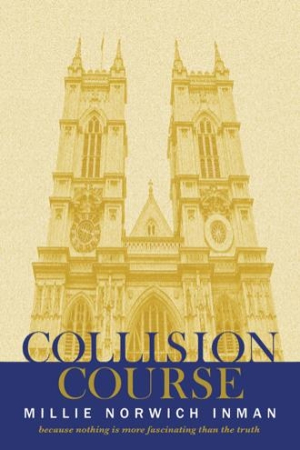Collision Course
Opening the Floodgates for the American Revolution
The historical novel Collision Course dramatizes King George III’s premature coming-of-age and the early days of his reign.
In Millie Norwich Inman’s historical novel Collision Course, a prince is thrust into politics after the death of his father.
In eighteenth-century England, the prince of Wales dies, shattering twelve-year-old George’s childhood and forcing him into political life early. Now the man of his family, he works to reestablish their wealth and political standing. As he’s tutored and prepared to take the throne, he navigates a bevy of political hazards too. He also befriends his tutor, Bute, and an up-and-coming member of Parliament, William; the three become major movers for England, shaping its prospects and the fates of the American colonies. In time, George transforms from a naive, hopeful child into a controversial monarch.
This dramatized depiction of King George III’s early life draws upon his correspondence at length, lifting some passages verbatim from his letters and journals. The historical background is filled in via expositional exchanges in which people discuss important scientific, economic, and technological advances. And the book’s general language is reflective of era mannerisms—and George’s maturation: as he shifts away from childhood, he stops using immature nicknames for those around him, for example. And when scenes shift away from courtly settings, their language becomes even more formal—almost Victorian in tone.
Covering a period of approximately a decade, the book’s pace is methodical. This somewhat reflects the slow nature of politics in general, as well as the period’s long communication delays. The tumult in the colonies receives frequent mention, becoming a regular source of tension; fallout from European battles also complicates the men’s lives. Individual relationships and diverging storylines are used to fill in the gaps between international events, as are asides for the sake of historical context. There are some intense romantic connections involved, as well as discourses on philosophy. Deviations to cover Bute’s time with his wife and growing family are also included.
Though George is the book’s ostensible hero, he is sometimes outshone by secondary characters, including William, a hardworking, moral member of Parliament who’s followed from his initial interactions with George through to his steady political ascension. Indeed, his drive to improve England for his contemporaries and for future generations makes him vibrant. Throughout the book, he has personality clashes with most of his colleagues, but he still remains steadfast in his convictions. The book winds down as he masters his role and the events in the colonies come to a head; the somewhat open-ended conclusion foreshadows the king’s future troubles.
In the historical novel Collision Course, a flawed, underprepared monarch contends with betrayals and forms alliances in the days leading up to the American Revolution.
Reviewed by
John M. Murray
Disclosure: This article is not an endorsement, but a review. The publisher of this book provided free copies of the book and paid a small fee to have their book reviewed by a professional reviewer. Foreword Reviews and Clarion Reviews make no guarantee that the publisher will receive a positive review. Foreword Magazine, Inc. is disclosing this in accordance with the Federal Trade Commission’s 16 CFR, Part 255.

